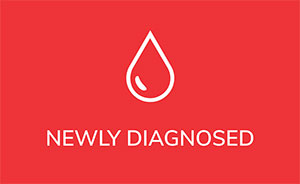
By Michael Choi, MD
It is a tremendous understatement to say that one should not take a “one-size fits all” approach to the treatment of patients with chronic lymphocytic leukemia. There is tremendous variability in all aspects of the disease. While some patients remain without symptoms for several years, others can have signs of disease progression fairly soon after diagnosis. Likewise, response to treatment varies as well; some patients have remissions lasting even more than 10 years after receiving chemo-immunotherapy, whereas others may not respond as well or at all.
It is in that context that “prognostic markers” can help patients and their doctors have a better sense of typical outcomes for patients with similar markers. You may have heard or read about some of these, like ZAP-70 expression, or rearrangement of the immunoglobulin heavy chain gene. A key caveat is that the markers are never 100% predictive for any single patient. There are always exceptional cases that don’t fit the model.
That said, it has become very clear that the FISH test for Deletion 17p (and other DNA changes) is a key part of evaluating patients with CLL, especially in deciding on optimal treatment. In the following sections, we’ll discuss this test, what it means biologically, and how we use it clinically.
What is a FISH test?
Some background first. Each of our cells contains DNA, which is packaged into 23 strands, called chromosomes. Each cell has 2 copies of each chromosome, one that was originally inherited from each parent. In many types of cancer, these chromosomes become altered in the cancer cells. Sometimes entire chunks of a chromosome move to another, or are copied, or are just plain missing, or “deleted”. In patients with CLL, the most common chromosomal abnormalities are: Deletion of part of chromosome 11 (Del11q), a extra (third) copy of chromosome 12 (Trisomy 12), deletion of part of chromosome 13 (Del13q), and deletion of part of chromosome 17 (Del17p).
The FISH test is a way of looking for those changes. FISH stands for “Fluorescence In Situ Hybridization”, which means that fluorescent tags have been designed to bind to the chromosome/DNA sequences of interest. For example, if a cell has Del17p, then no signal or only 1 signal is seen with that probe instead of the normal 2.
Why is Del17p so important?
Each chromosomal change has a different impact because of the specific DNA sequence that is contained in that part of the chromosome. In the case of Del17p, the DNA that has been lost includes a very important gene that encodes a protein called p53. This gene is a critical part of responding to DNA damage, and has been referred to as the “guardian of the genome”. If a cell detects a small amount of DNA damage, p53 coordinates the cell to slow down its replication (it doesn’t want to pass along the mistake to its next generation) and repair the problem. If the DNA damage, however, is too severe to salvage, then p53 will coordinate for the cell to die.
It turns out the p53 has a critical role in the effectiveness of chemotherapy and other cancer treatments. Many of these treatments depend on inflicting damage that is then detected by p53, which then triggers the death of the cancer cell. But if a cancer cell has Del17p and therefore no p53, it will be resistant to chemotherapy. This is why patients with Del17p have lower response rates and shorter remissions with regimens like FCR or Bendamustine.
What about Del11q?
Chromosome 11 encodes for a protein called ATM (ataxia telangiectasia mutated). This is also a protein involved in detecting and coordinating a response to DNA damage. For instance, one of the proteins it activates is the p53 protein itself. Early studies showed that patients with Del11q also did less well with chemotherapy treatment, though it appears that the addition of rituximab (or presumably other monoclonal antibodies) overcomes this. I take this to mean that single agent chemotherapy may depend of ATM for its full effectiveness, but that monoclonal antibodies may activate the death of the cell with or without ATM.
How do we use these results clinically?
Based on the clear connection between Del17p and resistance to standard chemotherapy, I consider it absolutely necessary to do a FISH test (and chromosome analysis) at any time that we are deciding on a course of treatment. Del17p and other chromosomal changes may appear during the course of the disease too. It may not be present or detectable when somebody is first diagnosed, but may be detected later, so I send the FISH test from the blood or bone marrow at every treatment point.
If the result is Del17p in even a small fraction of cells (>10% if the general cutoff), then I counsel patients to not receive standard chemo-immunotherapy treatment. The “risk vs reward” ratio is just too unfavorable, as the treatment will have all of the same side effects as it would without Del17p, but with much less of a chance of a deep or sustained remission. Fortunately, the newer CLL therapies have been designed to be effective even in cases with Del17p. Drugs like the B-cell receptor (BCR) antagonists (ibrutinib, acalabrutinib, idelalisib, and others) suppress other critical pathways, and the BCL-2 inhibitor (venetoclax) bypasses p53 and to activate the cell death pathway.
I typically do not change my treatment recommendations if Del11q is found. However, it has been shown that the overall prognosis is still slightly worse with this change, even with ibrutinib. Therefore, patients with CLL and Del11q may have access to novel agents through various clinical trials for “high-risk CLL”.
Michael Choi, MD is a Clinical Instructor at Moores UCSD Cancer Center and Professor of Medicine at the University of California San Diego, School of Medicine in San Diego, CA.
Originally published in The CLL Tribune Q3 2016.

















